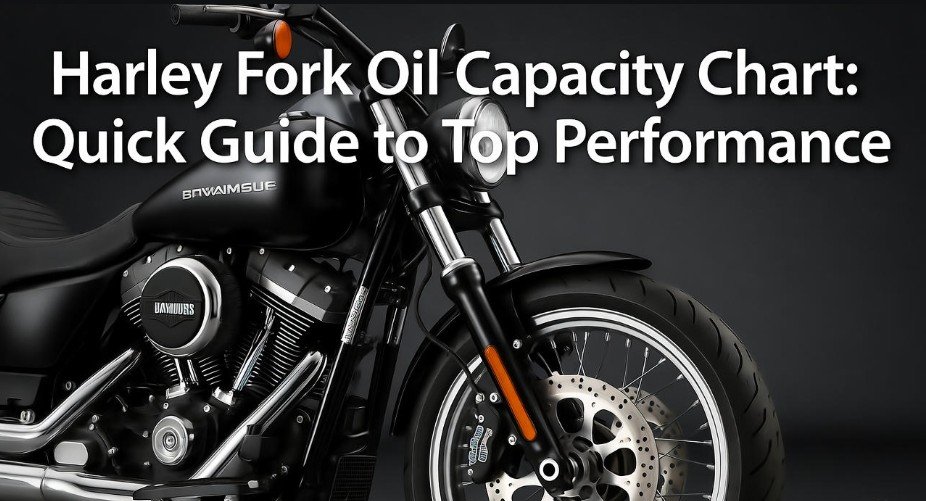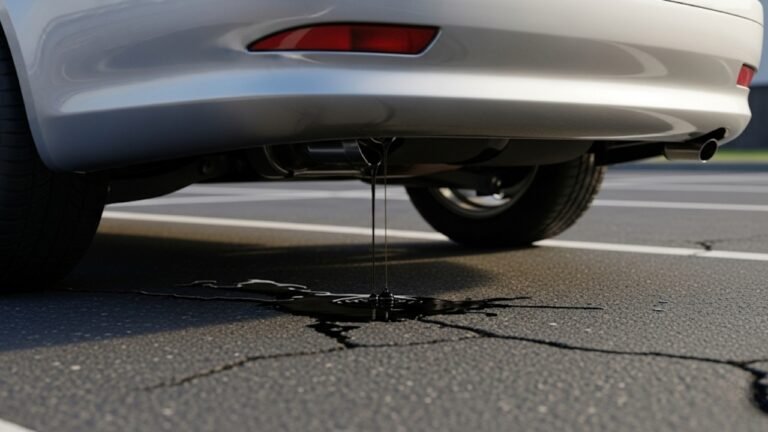Harley Fork Oil Capacity Chart: Quick Guide to Top Performance

Keeping your Harley-Davidson in top condition isn’t just about the shine on the chrome or the rumble of the exhaust—it’s about precision. One small detail that often gets overlooked but plays a huge role in ride quality and performance is the fork oil capacity. Think of the fork oil as your bike’s secret ingredient—it cushions every bump, absorbs every shock, and keeps your front suspension silky smooth.
If you’ve ever felt your ride getting rougher or noticed instability during sharp turns, it might be time to check that oil. Understanding the Harley fork oil capacity chart will help you maintain the perfect balance for your bike’s suspension. In this guide, we’ll dive deep into how to determine the right fork oil level, how to check and refill it, and why it’s crucial for the longevity of your Harley.
Introduction: Why Fork Oil Matters More Than You Think

Every Harley rider knows that the joy of cruising down the highway isn’t just about speed—it’s about control. And control starts with your front suspension. The fork oil inside your Harley’s front forks acts as a hydraulic fluid that keeps your suspension smooth, responsive, and stable.
Over time, the oil can degrade, losing its viscosity and effectiveness. Think of it like running shoes—you wouldn’t go jogging with worn-out soles, right? Similarly, running your Harley with old fork oil can make your suspension sluggish and uneven.
Here’s what proper fork oil maintenance ensures:
-
Smoother rides with better shock absorption
-
Improved handling and steering stability
-
Longer suspension life by reducing friction
-
Safer rides through consistent front-end performance
So, keeping your fork oil capacity accurate isn’t just maintenance—it’s the backbone of your bike’s comfort and safety.
The Role of Fork Oil in Harley-Davidson Motorcycles
The fork oil in your Harley isn’t just any fluid—it’s the lifeblood of your suspension system. When your front wheel hits a bump, the fork compresses, and the oil inside dampens that impact, ensuring you don’t feel the full force of it.
Too little oil, and your forks might “bottom out,” making your front end feel mushy and unstable. Too much oil, and the ride becomes harsh, with little room for compression. The trick lies in maintaining the ideal Harley fork oil capacity for your specific model.
Most riders underestimate how much a small imbalance can affect performance. Even a few ounces off can change how your bike feels on the road. It’s like seasoning a perfect dish—too much or too little salt can ruin the flavor. The same principle applies to fork oil.
Understanding the Importance of Correct Fork Oil Levels
The correct fork oil level ensures that your suspension behaves predictably, no matter the terrain. Imagine gliding over a rough patch of road, your handlebars steady, your body relaxed—that’s the work of properly maintained fork oil.
Here’s how it affects your Harley’s performance:
-
Too Little Oil → Soft suspension, increased dive during braking, instability on uneven roads.
-
Too Much Oil → Harsh ride, stiff front end, potential seal leaks due to excessive pressure.
-
Right Amount → Perfect balance, responsive handling, and smoother cornering.
Maintaining the ideal oil level not only improves comfort but also prevents expensive repairs. Fork seals, springs, and internal valves all depend on clean, well-balanced oil to function correctly.
If you ever notice excessive fork dive or a “spongy” front end, it’s a clear sign that your fork oil may be low—or long overdue for a change.
Breaking Down the Harley Fork Oil Capacity Chart
Before diving into maintenance, it’s important to understand the Harley fork oil capacity chart. This chart gives you a quick reference for how much oil each model requires. Different models have different fork sizes and internal designs, which means the oil quantity can vary significantly.
Here’s an overview of common Harley models and their average oil capacities:
| Harley Model | Fork Oil Capacity (oz) |
|---|---|
| Harley Sportster | 10.2 oz |
| Harley Softail | 11.6 oz |
| Harley Dyna | 12.3 oz |
| Harley Touring | 13.5 oz |
Now, these are general figures. Variations exist based on year and sub-models (e.g., Fat Boy vs. Heritage Softail). Always verify with your owner’s manual or the official Harley-Davidson service chart for exact specifications.
Knowing this data saves you from guesswork and ensures your bike performs at its best—every single time you hit the road.
How to Read and Interpret the Fork Oil Chart
At first glance, the Harley fork oil capacity chart may seem confusing—but it’s actually simple once you understand the layout. Each row represents a specific Harley model and its required oil amount. Some charts even break it down further by fork type (standard, cartridge, or inverted).
Here’s an example:
| Model | Year | Fork Type | Oil Capacity (oz) |
|---|---|---|---|
| Sportster | 2015 | Standard | 11.6 |
| Softail | 2018 | Springer | 12.5 |
From this, you can see that even within the same model line, the fork type and production year can alter the oil capacity. That’s why using one universal number across all Harleys isn’t accurate.
To ensure precision:
-
Check your VIN for the exact year and model.
-
Reference the owner’s manual or the Harley service guide.
-
Always measure oil accurately during maintenance.
This understanding not only ensures smoother performance but also prevents mechanical issues caused by incorrect oil levels.
Step-by-Step Guide to Checking Fork Oil in Your Harley
Checking your Harley’s fork oil doesn’t require a mechanic’s degree—it just takes a little patience, the right tools, and a methodical approach. Here’s a simple guide to help you do it right.
Tools You’ll Need:
-
A wrench set
-
Measuring cup or syringe
-
Drain pan
-
Fresh fork oil (per manufacturer’s recommendation)
-
Clean rags
-
Your Harley’s service manual
Safety Precautions:
-
Always secure your bike on a stable stand.
-
Wear safety gloves and goggles.
-
Work in a well-ventilated area with good lighting.
Steps to Follow:
-
Stabilize your Harley on a center stand or lift.
-
Remove the fork caps carefully using the appropriate wrench.
-
Drain the old oil into a pan by loosening the fork drain bolts.
-
Let it completely drain—patience matters here!
-
Measure fresh fork oil using your measuring cup.
-
Pour the new oil slowly into each fork tube.
-
Reinstall the fork caps and tighten them gently.
-
Wipe clean any excess oil and check for leaks.
Once complete, take your Harley for a short test ride. You’ll instantly feel the difference—a smoother, steadier, and more responsive front end.
Determining the Right Fork Oil for Your Harley
Choosing the correct fork oil isn’t just about quantity—it’s about quality and viscosity. Fork oils come in different grades, usually measured by weight (W). Common types include 5W, 10W, 15W, and 20W.
A lighter oil (like 5W) provides smoother, softer suspension—ideal for city rides or light cruising. A heavier oil (15W–20W) offers firmer damping, suitable for riders who prefer sharper handling or often ride on rough terrain.
Here’s a general guide:
| Riding Style | Recommended Oil Type |
|---|---|
| Daily commuting / city rides | 5W – 10W |
| Long-distance touring | 10W – 15W |
| Performance or racing setup | 15W – 20W |
If you’re not sure which to pick, stick with the manufacturer’s recommended oil. Using the wrong viscosity can alter your suspension dynamics and affect handling.
A personal tip from seasoned Harley riders: experiment cautiously. Start with the recommended oil, and if your suspension feels too soft or too firm, make small adjustments. That’s how you’ll find your perfect setup.
Draining and Refilling Harley Fork Oil Like a Pro
When it comes to draining and refilling fork oil, precision is everything. The process may look simple, but doing it right can transform your Harley’s ride quality.
Draining the Old Oil
-
Lift your motorcycle securely using a jack stand.
-
Locate the fork drain bolts—usually near the bottom of the forks.
-
Place your drain pan underneath.
-
Loosen the bolts and allow the oil to drain completely.
-
Once done, replace the bolts and clean the area.
Draining removes old, contaminated oil filled with microscopic debris that affects performance.
Refilling the Fresh Oil
-
Check your Harley fork oil capacity (refer to your model-specific chart).
-
Measure the exact amount using a precise measuring cup.
-
Slowly pour new fork oil into the tubes using a funnel.
-
Reattach the fork caps securely.
-
Test the suspension movement before riding.
Remember, overfilling leads to a harsh ride and seal leaks, while underfilling causes excessive fork dive and instability. Stick to the recommended levels for the smoothest results.
Adjusting Fork Oil for Custom Performance
If you’ve ever wished your Harley could glide just a bit smoother over rough roads—or handle corners with a sharper, sportier feel—then adjusting your fork oil might be the secret sauce you’ve been missing. Fine-tuning fork oil levels and viscosity lets you tailor your suspension to your personal riding style, whether you’re a long-distance cruiser or a thrill-seeking corner carver.
Tuning for Comfort
For riders who love long, relaxed rides and highway cruising, comfort comes first. A softer front suspension absorbs bumps effortlessly, reducing fatigue and allowing your Harley to “float” over uneven surfaces. To achieve this:
-
Use lighter fork oil (5W–10W) for smoother damping.
-
Make sure oil levels are slightly below the maximum limit for extra plushness.
-
Replace fork oil regularly—at least once every two years—to maintain consistency.
Lighter oil flows faster through the damping system, softening the response. It’s perfect for city rides and long tours where you want a smooth, cushiony feel.
Tuning for Handling and Control
Now, if your passion lies in sharp turns and precise control, a firmer front end is key. You’ll want your Harley to feel responsive, agile, and confident under braking. To enhance handling:
-
Choose heavier fork oil (15W–20W) for stiffer damping.
-
Keep the oil level close to the manufacturer’s recommendation for maximum stability.
-
Consider mixing viscosities (like 10W and 15W) to achieve your ideal feel.
Heavier oil slows down fork movement, giving you more control during aggressive riding. The result? A more connected, confident front end—especially noticeable when leaning into corners or braking hard.
Troubleshooting Common Fork Oil Problems
Even the most well-maintained Harley can experience fork oil issues over time. Leaks, stiffness, or uneven suspension can creep up without warning—but the good news is that most problems are easy to diagnose and fix.
Fork Oil Leaks and How to Fix Them
If you spot oily residue on your fork tubes, it’s a clear sign of a leak. The most common culprit? Worn or damaged fork seals. These seals keep the oil contained, but dust and age can cause them to deteriorate.
To fix leaks:
-
Inspect fork seals for cracks or tears.
-
Clean the fork tubes with a microfiber cloth to remove dirt and debris.
-
If the leak persists, replace the seals with new ones using a seal driver tool.
A small tip: installing dust boots or fork gaiters can help protect your seals from road debris and extend their lifespan.
Dealing with Overfilling or Underfilling
Getting the oil level wrong can throw your suspension off balance. Overfilling makes the ride stiff and can cause seal failure. Underfilling makes your forks “bottom out,” which feels like hitting a curb every time you brake hard.
Here’s a quick comparison for clarity:
| Issue | Effect on Ride | Solution |
|---|---|---|
| Overfilled forks | Harsh, stiff ride | Drain a few ounces of oil |
| Underfilled forks | Soft, bouncy ride | Add correct amount of oil |
| Dirty or old oil | Poor damping, uneven response | Replace oil immediately |
A good rule of thumb—always measure fork oil with precision, and never eyeball it. A small measuring error can make a big difference in performance.
Maintaining Optimal Fork Oil Levels for Longevity
A well-maintained fork system not only enhances comfort but also extends the lifespan of your Harley’s front suspension. It’s like taking care of your spine—ignore it, and the whole body suffers.
Routine Check-ups Matter
Checking your fork oil regularly is one of the simplest ways to ensure consistent performance. Here’s what a proper maintenance schedule should look like:
-
Inspect fork oil every 3,000 miles for clarity and level.
-
Replace oil every 10,000–20,000 miles or every two years.
-
Check seals and gaskets during each service for signs of leakage.
Clean, fresh fork oil prevents internal wear, reduces heat buildup, and ensures your front suspension remains smooth and responsive.
Long-Term Fork Health Tips
Think of fork maintenance as an investment in your Harley’s future. Simple habits go a long way:
-
Always use high-quality fork oil recommended by Harley-Davidson.
-
Keep your forks free of dirt and bugs that can damage seals.
-
Avoid prolonged storage without movement—fork seals stay healthier when the suspension is exercised occasionally.
Regular care keeps your Harley performing as it should—stable, balanced, and ready for adventure.
Advanced Tips for Enthusiastic Riders
For riders who love pushing their Harley to the limit, there are a few advanced techniques that can take your suspension performance to another level. This section is all about those small tweaks that create big results.
Custom Oil Mixes
Mixing fork oils of different viscosities allows you to create a personalized damping feel. For example, blending 10W and 15W can give you a middle-ground setup—great for riders who want both comfort and control.
Using Fork Oil Additives
Additives can enhance performance and extend component life. Some popular ones include:
| Additive Type | Function |
|---|---|
| Anti-foaming agents | Prevent air bubbles that affect damping |
| Seal conditioners | Keep seals flexible and reduce leakage |
| Friction modifiers | Improve fork smoothness and reduce stiction |
These additives help maintain consistency in oil performance, especially during long rides or extreme temperatures.
Expert Tips for Racing or Heavy-Duty Riding
If you use your Harley for track days or heavy touring, small adjustments can make a big difference:
-
Test multiple oil weights to find your ideal setup.
-
Record changes in a maintenance log to track what works best.
-
Consult professionals for suspension tuning if you frequently ride at high speeds.
Think of this as fine-tuning a musical instrument—when every note is balanced, the result is harmony. Your Harley will respond just as precisely once your fork oil setup is perfected.
FAQs About Harley Fork Oil Capacity
1. What exactly does fork oil do in a Harley-Davidson?
Fork oil acts as a hydraulic fluid that dampens shocks from the road. It keeps your front suspension smooth, stable, and responsive, improving both comfort and control.
2. How often should I change my Harley’s fork oil?
Ideally, every 20,000 miles or two years, whichever comes first. However, if you ride on rough terrain frequently, it’s wise to replace it sooner.
3. Can I use any motorcycle fork oil in my Harley?
No. Always use the specific fork oil recommended by Harley-Davidson or a trusted equivalent. Using the wrong oil can alter damping characteristics and damage your suspension.
4. What are the signs that my fork oil needs replacing?
You might notice front-end wobble, excessive dive during braking, leaks around the fork seals, or a “spongy” feeling when riding.
5. Can I adjust fork oil levels myself, or should I visit a mechanic?
If you’re confident and have the right tools, you can do it at home. But if it’s your first time or your model has a complex fork setup, professional service is recommended.
6. Does temperature affect fork oil performance?
Yes. Extreme heat can thin the oil, reducing damping. Conversely, cold weather can make it thicker, stiffening the suspension. Always check oil viscosity suitable for your climate.
7. Is overfilling the fork oil dangerous?
Absolutely. Overfilling can cause internal pressure buildup, leading to blown seals or a harsh, uncomfortable ride. Always follow the Harley fork oil capacity chart for accurate measurements.
Conclusion: Your Harley Deserves Precision
At the end of the day, maintaining your Harley fork oil capacity isn’t just another routine task—it’s a reflection of how much you value your ride. Just like a musician tunes his guitar before every performance, a rider should ensure his forks are in perfect harmony with the road.
By keeping your fork oil levels accurate, you’re not only enhancing performance—you’re preserving the soul of your Harley-Davidson. The road feels smoother, the corners sharper, and every mile becomes a pleasure instead of a chore.
So the next time you’re prepping for a long ride, take a moment to check that fork oil. That small step can be the difference between an ordinary trip and an unforgettable journey.
Ride safe, ride smooth, and let your Harley glide the way it was meant to.






